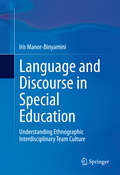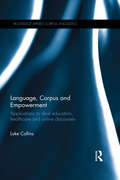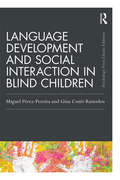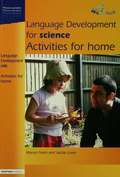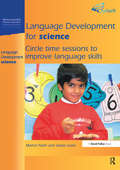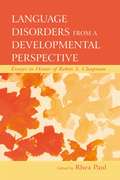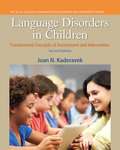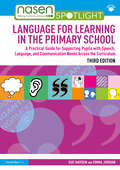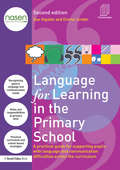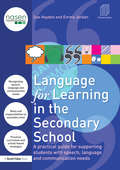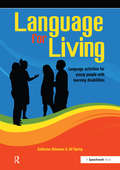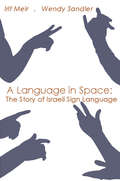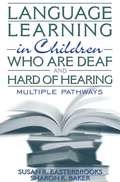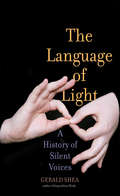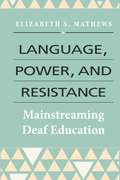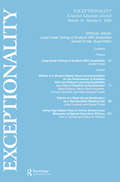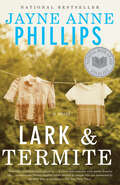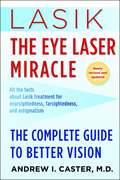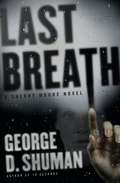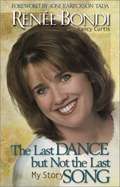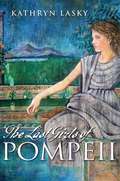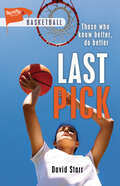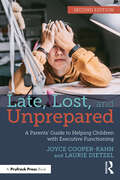- Table View
- List View
Language and Discourse in Special Education
by Iris Manor-BinyaminiThis book examines the words and discourse as well as their meaning and impact on the everyday culture of a multidisciplinary team at a school for students with mental disabilities. The book examines the organizational, social, professional, and emotional experiences of team members from such disciplines as child and school psychology, special education, therapy (e. g. , occupational, speech), social work, and pediatric medicine within a special education school. It explores the ways in which team members describe and interpret the day-to-day requirements of working effectively in a special education school, using their own language and discourse from a subjective point of view. In addition, the book analyzes and interprets the influence of language and discourse on the outlook, behavior patterns, and the coping of team members working in the school with the students, among themselves as a team, and with the difficulties and dilemmas that concern them as well the solutions that they themselves introduce for all these issues. This book, with its focus on the unique and complex work environment of the multidisciplinary special education team, is essential reading for researchers, professionals, and graduate students in child and school psychology, therapeutic disciplines (e. g. , occupational, speech), social work, pediatric medicine, and allied mental health and medical fields.
Language, Corpus and Empowerment: Applications to deaf education, healthcare and online discourses (Routledge Applied Corpus Linguistics)
by Luke CollinsLanguage, Corpus and Empowerment applies a novel corpus-driven approach to the exploration of the concept of empowerment in healthcare. The book proposes an innovative corpus-based methodology for finding evidence of empowerment in language use, using data from a video intervention delivered to families of deaf children, as well as assessing the effects of the intervention on the family. Language, Corpus and Empowerment provides a working definition of empowerment which incorporates concepts from linguistics and learning theory; uses corpus analysis to provide evidence of how video interventions can transform people’s perspectives; examines this new methodology as a potential tool for analysing conversational data longitudinally and at a case-by-case level; demonstrates how a corpus-based methodological approach can be applied in conjunction with other language-based approaches, such as discourse analysis and conversation analysis, to explore the ways in which complex social processes occur in interaction; makes a valuable development in the assessment of the impact of healthcare interventions and the language of empowerment. Insightful and ground-breaking, Language, Corpus and Empowerment is essential reading for anyone undertaking research within corpus linguistics.
Language Development and Social Interaction in Blind Children (Psychology Press & Routledge Classic Editions)
by Gina Conti-Ramsden Miguel Perez-PereiraThe Classic Edition of this foundational text includes a new preface from Miguel Pérez-Pereira, examining how the field has developed since first publication. The volume provides an in-depth account of blind children's developing communicative abilities, with particular emphasis on social cognition and language acquisition from infancy to early school age. It provides insights into why the development of blind children may differ from that of sighted children and explores development of "theory of mind" and perspective taking in language learning. It also discusses the caregiver–child interaction, research on early intervention and practical strategies for blind children that can assist parents and practitioners. The up-to-date preface discusses recent neurological research and the comparison between the psychological development of visually impaired and autistic children. Language Development and Social Interaction in Blind Children continues to facilitate dialogue between those interested in the study of typically developing children and those interested in the development of children who are blind, and challenges some widely held beliefs about the development of communication in blind children.
Language Development for Science: Activities for Home
by Marion Nash Jackie LoweThese simple play-based activities are ideal for teachers to copy and give out to parents who want to know how to help their child improve his or her science language skills and have fun at the same time. Activities are linked directly to the school-based Language Development Circle Time sessions, but can also be used independently. There is a clear structure and progression of ideas, with supporting black-line drawings to acts as prompts and simple record - keeping system to support home/school communication.
Language Development for Science: Circle Time Sessions to Improve Language Skills
by Marion Nash Jackie LoweThis book is the first of its kind to help practitioners specifically develop children's language skills in Science. The book incudes: guidelines to help teachers set up, run and assess circle-time sessions ideas for promoting children's thinking skills and emotional literacy video CD containing explanation and demonstration of the programme and its implementation, with comments from staff who have used it.
Language Disorders From a Developmental Perspective: Essays in Honor of Robin S. Chapman (New Directions in Communication Disorders Research)
by Rhea PaulThe last 25 years have witnessed an explosion of research at the intersection of typical language development and child language disorders. A pioneer in bringing these fields of study together is Robin S. Chapman, Emerita, University of Wisconsin. This contributed volume honors her with chapters written by former students and colleagues, who track in their own research the theme of psycholinguistic contributions to our understanding of the nature and remediation of child language disorders. In this volume, such renowned researchers in child language development as Dorothy Bishop, Judith Johnston, and Ray Kent, among others, discuss their research in certain populations in the context of the significance of, limits of, and alternatives to Robin Chapman’s developmental interactionist perspective. Studies of disordered language in Down’s Syndrome and Specific Language Impairment, in particular, attribute much progress in our understanding of the pragmatic and comprehension skills in these populations to the developmental perspective. Language Disorders From a Developmental Perspective opens with a reprint of Robin Chapman’s seminal 2001 article from The Journal of Child Psychiatry and Psychology. It concludes with a new chapter from Dr. Chapman summarizing what we know and what we don’t know about language disorders within the developmental framework, and pointing to future areas of research and intervention. Clinicians as well as scholars will benefit from this book, as will students in programs of developmental psycholinguistics, child language disorders, and learning disabilities.
Language Disorders in Children: Fundamental Concepts of Assessment and Intervention
by Joan N. KaderavekThis text is more than an introductory look at language disorders. It goes beyond basic concepts and basic definitions to teach students how to analyze, synthesize, evaluate, and link the information they are learning. It offers readers opportunities for higher-order learning, while preparing students to become careful evaluators of information, as well as adept problem solvers. Organized by disorder groups and theme, Language Disorders in Children, 2/e helps students easily make connections between theoretical information and clinical practice through a number of thoughtful features such as case histories, clinical decision trees, and hot topic discussions. It's an approach that meets the needs of today's students to learn lifetime critical thinking skills, to see relationships between isolated ideas and facts, and to think like a speech-language pathologist.
Language for Learning in the Primary School: A Practical Guide for Supporting Pupils with Speech, Language and Communication Needs Across the Curriculum (nasen spotlight)
by Sue Hayden Emma JordanThe third edition of Language for Learning in the Primary School is an indispensable resource, packed full of practical suggestions on how to support 5-11-year-old children with speech, language, and communication needs. Colour coded throughout for easy referencing, this unique book supports inclusive practice by helping teachers to: Identify children with speech, language, and communication needs (SLCN) Understand speech, language, and communication skills Consider roles and responsibilities at primary school Plan a differentiated and adapted curriculum Consider the language demands across subjects Adopt a whole-school approach Make use of a wide range of positive strategies to support children in the classroom Empower children to access the curriculum Fully revised and updated, Language for Learning in the Primary School, 3rd edition, comes complete with a wealth of photocopiable and downalodable resources, giving teachers and teaching assistants the confidence to help children with SLCN more effectively in mainstream settings. It will also be an extremely useful resource for speech and language therapists, specialist teachers, and educational psychologists.
Language for Learning in the Primary School: A practical guide for supporting pupils with language and communication difficulties across the curriculum (nasen spotlight)
by Sue Hayden Emma JordanLanguage for Learning in the Primary School is the long awaited second edition of Language for Learning, first published in 2004 and winner of the NASEN/TES Book Award for Teaching and Learning in 2005. This handbook has become an indispensable resource, packed full of practical suggestions on how to support 5-11 year old children with speech, language and communication difficulties. Colour coded throughout for easy referencing, this unique book supports inclusive practice by helping teachers to: Identify children with speech, language and communication needs (SLCN) Understand speech, language and communication skills Consider roles and responsibilities at primary school Plan a differentiated and adapted curriculum Consider the language demands across subjects Adopt a whole school approach Make use of a wide range of positive strategies Empower children to access the curriculum Language for Learning in the Primary School comes complete with a wealth of photocopiable resources, giving teachers and teaching assistants the confidence to help children with SLCN more effectively in mainstream settings. It will also be an extremely useful resource for speech and language therapists, specialist teachers and educational psychologists.
Language for Learning in the Secondary School: A Practical Guide for Supporting Students with Speech, Language and Communication Needs (nasen spotlight)
by Sue Hayden Emma JordanLanguage for Learning in the Secondary School employs the same easy-to-use format as the best-selling Primary version of this book but has been adapted to meet the specific needs of secondary school teachers. This indispensable resource is packed full of practical suggestions on how to support students with speech, language and communication difficulties. Colour coded throughout for easy referencing, this unique book supports inclusive practice by helping you to: Identify students with speech, language and communication needs Understand how language is processed Consider roles and responsibilities at secondary level Plan a differentiated curriculum Consider the language demands across the subjects Adopt a whole school approach Make use of a wide range of positive strategies Empower students to access the curriculum. Language for Learning in the Secondary School comes complete with a wealth of photocopiable resources and activities, giving teachers and teaching assistants the confidence to help students with speech, language and communication needs more effectively in mainstream settings. It will also be an extremely useful resource for specialist teachers, speech and language therapists and educational psychologists.
Language for Living: Communication Activities for Young Adults with Learning Difficulties
by Catherine DelamainThis title features communication activities for young adults with learning difficulties. This unique collection of 180 enjoyable group activities aims to foster both the skills underlying communication, such as body language and awareness of others, and aspects of spoken language itself. The activities fall broadly within the Entry Levels 1-3 of the Skills for Life Core Curriculum, but can be used as a completely independent programme. The book addresses the needs of students with very varied skill levels, and includes some activities which can be used with non-verbal students. "Language for Living" has the following advantages: no formal assessment necessary; equipment not required or kept to a minimum; activities can be freely adapted to suit students' lifestyles and experience; activities are simple to organise, and easy to fit in to the daily programme of college, day or residential settings; photocopiable resource section; and CD-ROM for optional record-keeping and printable resources.
A Language in Space: The Story of Israeli Sign Language
by Irit Meir Wendy SandlerThis English version of A Language in Space: The Story of Israeli Sign Language, which received the Bahat Award for most outstanding book for a general audience in its Hebrew edition, is an introduction to sign language using Israeli Sign Language (ISL) as a model. Authors Irit Meir and Wendy Sandler offer a glimpse into a number of fascinatin
Language Instruction for Students with Disabilities (3rd edition)
by Edward A. Polloway Lynda Miller Tom E. C. SmithLanguage development and language competence are recognized as critical emphases in the education of all children, and certainly those who experience disabilities. The substantial amount of research and programming in the diverse fields within the language domain reflects this emphasis.
Language Learning in Children Who Are Deaf and Hard of Hearing: Multiple Pathways
by Susan R. Easterbrooks Sharon BakerThis book addresses the language development process from multiple perspectives, drawing on the latest research in bilingual biculturalism, cochlear implant technology and neuroscience. The book presents a unique view of language development, proposing that there are multiple pathways to the acquisition of a system of communication. For parents and educators working with deaf and hard of hearing children.
The Language of Light: A History of Silent Voices
by Gerald SheaA comprehensive history of deafness, signed languages, and the unresolved struggles of the Deaf to be taught in their unspoken tongue Partially deaf due to a childhood illness, Gerald Shea is no stranger to the search for communicative grace and clarity. In this eloquent and thoroughly researched book, he uncovers the centuries-long struggle of the Deaf to be taught in sign language—the only language that renders them complete, fully communicative human beings. Shea explores the history of the deeply biased attitudes toward the Deaf in Europe and America, which illogically forced them to be taught in a language they could neither hear nor speak. As even A.G. Bell, a fervent oralist, admitted, sign language is "the quickest method of reaching the mind of a deaf child." Shea’s research exposes a persistent but misguided determination among hearing educators to teach the Deaf orally, making the very faculty they lacked the principal instrument of their instruction. To forbid their education in sign language—the “language of light”—is to deny the Deaf their human rights, he concludes.
Language, Power, and Resistance: Mainstreaming Deaf Education
by Elizabeth S. MathewsThe current policy of educating d/Deaf and h/Hard of hearing (DHH) students in a mainstream setting, rather than in the segregated environments of deaf schools, has been portrayed as a positive step forward in creating greater equality for DHH students. In Language, Power, and Resistance, Elizabeth S. Mathews explores this claim through qualitative research with DHH children in the Republic of Ireland, their families, their teachers, and their experiences of the education system. While sensitive to the historical context of deaf education, Mathews focuses on the contemporary education system and the ways in which the mainstreaming agenda fits into larger discussions about the classification, treatment, and normalization of DHH children. The research upon which this book is based examined the implications that mainstreaming has for the tensions between the hegemonic medical model of deafness and the social model of Deafness. This volume explores how different types of power are used in the deaf education system to establish, maintain, and also resist medical views of deafness. Mathews frames this discussion as one of power relations across parents, children, and professionals working within the system. She looks at how various forms of power are used to influence decisions, to resist decisions, and to shape the structure and delivery of deaf education. The author’s findings are a significant contribution to the debates on inclusive education for DHH students and will resonate in myriad social and geographic contexts.
Large-scale Testing of Students With Disabilities: A Special Issue of exceptionality
by Gerald TindalLarge Scale Testing of Students With Disabilities addresses three issues: accommodations, modifications, and reporting of outcomes. The purpose is not to present an exhaustive summary of the research in these areas but to focus attention on how the issues are considered and empirically validated. The research summarized in this issue should serve as a model for state departments to consider in adoption of policy, either as findings upon which to inform policy or as a method to adopt in generating findings themselves. The studies reflect critical methodologies that are either experimental in design or use extant data sets as well as present a theoretical framework in how to interpret empirical results.
Lark and Termite: A Novel (Vintage Contemporaries)
by Jayne Anne PhillipsA rich, wonderfully alive novel from one of our most admired and best-loved writers, her first book in nine years. Lark and Termite is set during the 1950s in West Virginia and Korea. It is a story of the power of loss and love, the echoing ramifications of war, family secrets, dreams and ghosts, and the unseen, almost magical bonds that unite and sustain us. At its center, two children: Lark, on the verge of adulthood, and her brother, Termite, a child unable to walk and talk but filled with radiance. Around them, their mother, Lola, a haunting but absent presence; their aunt Nonie, a matronly, vibrant woman in her fifties, who raises them; and Termite's father, Corporal Robert Leavitt, who finds himself caught up in the chaotic early months of the Korean War. Told with deep feeling, the novel invites us to enter into the hearts and thoughts of the leading characters, even into Termite's intricate, shuttered consciousness. We are with Leavitt, trapped by friendly fire alongside the Korean children he tries to rescue. We see Lark's dreams for Termite and her own future, and how, with the aid of a childhood love and a spectral social worker, she makes them happen. We learn of Lola's love for her soldier husband and her children, and unravel the mystery of her relationship with Nonie. We discover the lasting connections between past and future on the night the town experiences an overwhelming flood, and we follow Lark and Termite as their lives are changed forever.
Lasik: The Eye Laser Miracle
by Andrew I. CasterNow you can have normal vision all the time, thanks to excimer laser treatment-commonly known as PRK and LASIK-a painless procedure that takes less than five minutes. Dr. Andrew I. Caster, one of the leading physicians in the permanent correction of nearsightedness, astigmatism, and farsightedness, takes you through the entire process-including the experiences of patients who have undergone the procedure and their incredible joy at suddenly being able to see again.* What are the differences between the PRK, LASIK, and RK procedures, and which is right for me?* What are the most common side effects of excimer laser treatment?* How do I judge whether a doctor is sufficiently qualified to perform excimer laser treatment?* Will the procedure be painful?* When can I fully resume normal daily activities such as driving and reading?* Will eye laser treatment stop my eyes from getting worse?* How well has the FDA monitored this technique?* How many people have successfully undergone the procedure?The Eye Laser Miracle is the guide for anyone who wants better vision.From the Trade Paperback edition.
Last Breath: A Sherry Moore Novel
by George D. ShumanFollowing close on the heels of his celebrated debut 18 Seconds, George Shuman returns with yet another remarkable thriller featuring investigative consultant Sherry Moore -- a blind woman with an uncanny ability to view the final living moments of any dead body she encounters. A ruthless serial killer with an unthinkable MO has left a trail of tortured, murdered women in western Maryland and seems to have gone to ground in the backwoods of Pennsylvania. With no leads or any sign of a suspect, investigators must call on the now-famous blind psychic Sherry Moore, a woman whose talent inspires skepticism, but whose results are unparalleled. When she is put in contact with the hand of any dead body, she relives the memory of the departed's final experience. While investigating this case, she is privy to the most savage and terrifying scenes imaginable. However, because the killer is aware of her methods, he keeps his identity just beyond her reach until she resolves to put herself directly in harm's way. When the fiend sets his sights on Sherry, this seemingly helpless woman must demonstrate an almost inhuman strength of will and of body as she attempts to capture the deranged killer without having to pay the ultimate price in exchange. With Last Breath, George Shuman confirms his status as one of the most captivating thriller writers, and in Sherry Moore, he presents one of the most compellingly original protagonists the genre has ever seen.
The Last Dance But Not the Last Song: My Story
by Renee BondiRenee had it all... a dream job teaching high school choir and a wedding to plan for. life was good until a freak accident left her parilized from the shoulders down. inspiring story of faith and triumph
The Last Express (Duncan Maclain Mystery #1)
by Baynard KendrickWhen a bomb exploded in a New York subway car, killing the assistant D. A., it left a pair of puzzling survivors on the rear seat: two caged white mice. Who had put them there and why? Maybe a blind man could figure it out--if he had the amazing sensory powers of a Duncan Maclain. Captain Duncan Maclain, a blind detective, has a mystery to solve hidden in the labyrinth of New York's subway system. This is the first book in the series that inspired the popular television show "Longstreet."
The Last Girls of Pompeii
by Kathryn LaskyIn Pompeii, in the summer of A.D. 79, Julia and Sura appear to lead opposite lives. Julia is the daughter of a wealthy ship-builder; Sura is an orphan. Julia bears the Curse of Venus: a withered arm; Sura's beauty turns heads. Julia is free; Sura is her slave. Then Julia learns that her parents are planning to put her in the service of the Temple of Damia, the center of a cultish new religion, and Sura will be sold to an awful man who plans to make her his concubine. But when Mt. Vesuvius erupts, Julia's and Sura's fates are forever altered, forcing them both to face the true meaning of freedom.
Last Pick (Lorimer Sports Stories)
by David StarrGrowing up with a developmental condition that left her clumsy in both movement and speech, Jazz was teased and never had the chance to play team sports. Now rid of her symptoms, Jazz is ready to play basketball at her junior high, but the reappearance of an old bully makes her question herself and tempts her to let down the team that is counting on her. Last Pick emphasizes teamwork and countering bullying with fairness and forgiveness and how determination can help overcome obstacles. Distributed in the U.S by Lerner Publishing Group
Late, Lost, and Unprepared: A Parents’ Guide to Helping Children with Executive Functioning
by Joyce Cooper-Kahn Laurie DietzelDoes your child have difficulty meeting deadlines, staying organized, or keeping track of important information? Do they tend to forget details? Are they prone to emotional meltdowns? This book will become your go-to, all-inclusive guide to helping children manage issues with these executive functions, a set of related yet distinct mental skills that allow us to stay on target as we work toward our goals.Packed with encouragement, strategies, overviews, case studies, tips, and more, this newly revised edition offers science-based information explained in accessible, everyday language. You will find down to earth examples and a flexible framework that allows you to think on your feet and adapt the strategies to any child or situation.In addition to providing approaches for helping your child to manage demands in the short run, this book offers strategies for building independent skills for long-term self-management. Covering what you need to know, as well as what you can do, Late, Lost, and Unprepared gives parents the support they need to help their child become productive and independent – today and in the future.
